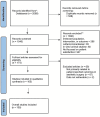A Systematic Review of Questionnaires Assessing Patient Satisfaction in Plastic Surgery: Tools, Topics, and Surgical Types
- PMID: 39281089
- PMCID: PMC11398821
- DOI: 10.1097/GOX.0000000000006156
A Systematic Review of Questionnaires Assessing Patient Satisfaction in Plastic Surgery: Tools, Topics, and Surgical Types
Abstract
Background: Patient satisfaction is crucial for evaluating healthcare services, including plastic surgery. This systematic review aims to analyze questionnaires assessing patient satisfaction in plastic surgery, identifying their strengths and weaknesses to improve outcomes and enhance the quality of care.
Methods: A comprehensive literature search was conducted using electronic databases. Studies were included if they were original research articles, written in English, and focused on patient satisfaction questionnaires in plastic surgery. Data extraction and descriptive statistics were used to summarize the data.
Results: A total of 105 studies were included. General/overall satisfaction was the most common topic addressed (99.04%). Cosmetic outcomes were the most frequently assessed category (34.3%). Breast reconstruction was the most common procedure (33.3%). Most studies used a combination of generic and procedure-specific questionnaires (45.71%). The most frequently used measurement tools were BREAST-Q and self-developed questionnaires, each accounting for 28.57% and 27.61%.
Conclusions: This review provides a comprehensive analysis of patient satisfaction questionnaires in plastic surgery, emphasizing the importance of a holistic approach and well-established, validated tools. The findings contribute to improving plastic surgery outcomes and enhancing the quality of care. Future research should refine assessment tools to address patients' needs and promote patient-centered outcomes in plastic surgery.
Copyright © 2024 The Authors. Published by Wolters Kluwer Health, Inc. on behalf of The American Society of Plastic Surgeons.
Conflict of interest statement
The authors have no financial interest to declare in relation to the content of this article.
References
-
- Bleustein CB, Rothschild DB, Valen A, et al. . Wait times, patient satisfaction scores, and the perception of care. Am J Manag Care. 2014;20:393–400. - PubMed
-
- Sofaer S, Firminger K. Patient perceptions of the quality of health services. Annu Rev Public Health. 2005;26:513–559. - PubMed
-
- Alderman AK, Bauer J, Fardo D, et al. . Understanding the effect of breast augmentation on quality of life: prospective analysis using the BREAST-Q. Plast Reconstr Surg. 2014;133:787–795. - PubMed
-
- Mira JJ, Tomás O, Virtudes-Pérez M, et al. . Predictors of patient satisfaction in surgery. Surgery. 2009;145:536–541. - PubMed
-
- Cano SJ, Klassen AF, Scott AM, et al. . The BREAST-Q: further validation in independent clinical samples. Plast Reconstr Surg. 2012;129:293–302. - PubMed
LinkOut - more resources
Full Text Sources

